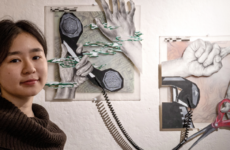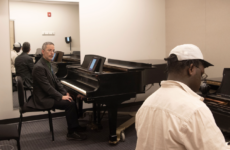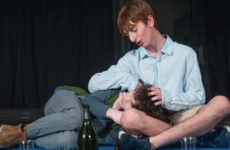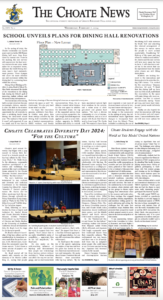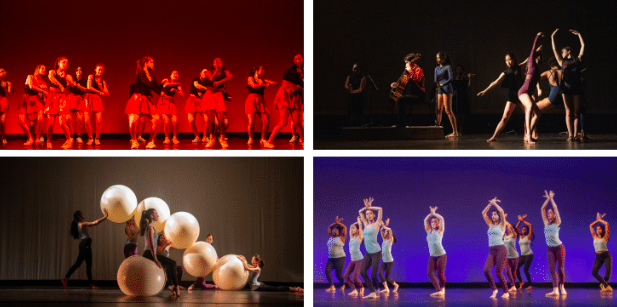
Photo by Toffy Prakittiphoom ’24/The Choate News
I.M. Pei’s Paul Mellon Arts Center (PMAC) stands proudly on the Choate campus as the budding home to inspiration and creativity. In this year’s annual Spring Dance Concert, the PMAC itself became a source of inspiration. Reflecting a remarkable variety in student and faculty choreographed pieces, the juxtaposition between I.M. Pei’s angular architecture and nature’s rounded shapes, large physioballs, and the spirit of Latin American dance forms inspired some of the pieces that will grace the PMAC stage on April 1 and 2.
“Artificial Nature”
by Mrs. Sandra Parks
When choreographing “Artificial Nature,” Mrs. Sandra Parks, the Arts Department Director, was greatly influenced by Pei’s work, including the PMAC. “He was inspired by nature a lot, but he used harsh lines to define nature for us in some way,” Mrs. Parks said.
Mrs. Parks created the first movement phrases for this piece from images of Pei’s architecture. While looking at the ubiquitous triangles, squares, and circles, she pondered what the “harsh line cutting through nature” meant to her. Explaining her thought process, she said, “That got me into a more of an emotional space and sort of just embodying those emotions was how the movement came about.” Mrs. Parks further explored the concept of contrast by showcasing the jarring juxtaposition between large movements and small gestures.
When she began her choreographic process, the Instrumental Ensembles Director, Mr. Gene Wie, reached out to Mrs. Parks with “Blue Motions” by Alan Terricciano for a potential project that the Dance and Music Departments could collaborate on. Coincidentally, the way that this piece for string quartet shifts from being energetic and abrupt in the beginning to being slow and smooth in the end aligned perfectly with Mrs. Parks’s exploration of the rigid architectural lines present in the rounded shapes of nature. For the performance, live musicians will be accompanying the dancers on stage.
Since the sharpness from the beginning of the music brought about a sense of confrontation, the piece starts with the dancers briskly walking toward the audience in silence. “We tend to not have that direct connection to the audience,” she said. “So I was like, alright, let me first go break that and see where the piece goes.”
Although the music for this piece was decided on prior to the start of rehearsals, the dancers did not dance with the music until the final weeks before the performance. “I did not want to have the dancers to go with the beat, but with the overall feeling,” said Mrs. Parks. Marissa Jacobs ’24, a dancer in “Artificial Nature”, added, “I think the music complements what I’m doing when I’m dancing. It’s not the driving force, but it helps with pacing and the quality of movement.”
“Cántalo”
by Irene GarciaGutierre ’22
Incorporating elements of flamenco, salsa, cumbia, perreo, and hip-hop, flamenco dancer Irene GarciaGutierre ’22’s “Cántalo” is a joyful experience for both the audience and the dancers. “I wanted to do a dance that resembled the parties I grew up with, and so I wanted to incorporate the different styles of dancing I saw in them,” she said. She chose the song “Cántalo” by Bad Bunny, Residente, and Ricky Martin to accompany her piece, which reflects the different styles of dance displayed. Staying true to the inspiration, she would blast the music for this piece in Colony Hall every Sunday, where she would have a dance party by herself. Through noting down the movements that came to her naturally when dancing to the pulsing rhythms of the music, she created a piece that brought a party to the stage.
Olivia Siegel ’24, a dancer in “Cántalo”, said of the piece: “The choreography is a lot about having fun and celebrating … we have a lot of good formations, we spin, and we trade partners — it’s very dynamic.”
“Your Higher Self”
by Ms. Shelley Morigno
“Your Higher Self” portrays the mysterious ways of the human mind and features a rather interesting prop — large physioballs. Dance Faculty member, Ms. Shelley Morigno, came upon this idea by accident when stretching with a physioball before teaching a class at Choate two years ago. “It just kind of dawned on me like, ‘oh,’ [it] would be really cool to create a piece with such a large complicated prop — complicated in the sense that it’s rolling [around and] moving,” Ms. Morigno said.
The relationship between the dancers and the physioballs represents the ideomotor effect, which is a hypnotic state that takes place when the brain takes control of what the body is doing without the mind being aware of it. The first half of the piece embodies the ideomotor effect with omnipresent physioballs and fluid movements; the latter half grapples with the difficulty of regaining awareness of the mind and body, which is depicted by sharp and fast movements, independent of the unpredictability of the physioballs. “It’s a contrast, and you have to switch mindsets,” said Yuko Tanaka ’22, a dancer in the piece, when describing the challenge of embodying the two phases of the ideomotor effect.
Final Thoughts
As this year’s pieces cover a wide array of styles, dancers have had to transition quickly between drastically different dances. “The dynamics of the movement is very different, and the presence you have to have on stage is different,” Siegel noted. “[However,] I think that it’s very entertaining for the audience to see such a variety because, otherwise, we’d get very monotone, especially in a longer show like ours.”
Dance is a product of any inspiration; the pieces in this year’s program are as unique as the choreographers and dancers who make up Choate’s Dance Company. Together, they showcase the diversity of dance present in the Choate community.

